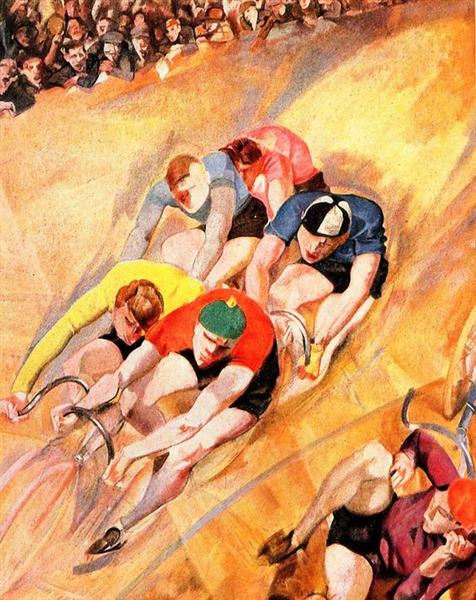Description
The "six-day race" painting (Six-Day Race) by Max Oppenheimer is presented as a vibrant and dynamic visual show that encapsulates the essence of the movement and emotion of the cycling competition, an issue that deeply resonated in the contemporary culture of early twentieth century. Oppenheimer, a prominent member of the expressionist movement, uses his talent to capture not only the physical action of cyclists, but also the fervor and tension emanating from the experience of the career itself.
The composition of the work is remarkable for its dynamic structure. In the center of the painting, cyclists concentrate on an intense act of competition, showing a skillful use of diagonal lines that lead the viewer's view through the fabric, creating a perception of incessant movement. Oppenheimer puts special emphasis on cyclists' silhouettes, which seem to almost flow and blur in their effort, providing a palpable speed sensation. This effect is further accentuated through color management, where dark and vibrant tones contrast with bright touches that enhance the energy of the scene.
The characters in the painting, although not individually detailed, are essential for the narrative of the work. Each cyclist represents not only the competitor on the track, but the dedication and resistance of the human spirit. The diversity of positions, positions and expressions of these individuals reflects the struggle and sacrifice involved in competition. These aspects invite the viewer not only to observe, but to feel the intensity of the race. In addition, the background of the work - a parade of fans and spectators - acts as a social ecosystem that complements the main action, highlighting the importance of the event in the community and culture of the time.
Color is a crucial tool in this work. The palette used by Oppenheimer combines earthly tones and vibrant nuances, creating a contrast that enhances the dramatic representation of the competition. The dark land and saturated cyclists stand out in front of a more hazy background, which directs the viewer's approach to the frantic movement in front. This use of color also suggests an almost festive atmosphere, despite the physical effort involved in the race. Such a characteristic is representative of a desire to capture life in its crudest and most sincere form, a concept that resonates with expressionist tendencies in the art of the time.
Oppenheimer, whose work is often associated with expressionism and symbolism, shows in this work its ability to merge these influences through emotion and movement. Throughout his career, he experienced with shapes and colors that tested the limits of artistic perception, and "six -day career" is a clear exemplification of such exploration. Although there is no broad information about the immediate context of this work, it is evident that Oppenheimer was interested in exploring issues of vitality and competitive spirit, at a time where they were increasingly relevant in the cultural spectrum.
In conclusion, "Max Oppenheimer's" race "not only captures a sporting event, but also stands as a reflection of the energy and spirit of an era. When articulating the fight and passion through artistically vibrant execution, Oppenheimer manages to connect with the viewer, taking it to a visual trip that is as full of life as the event it represents. The work thus becomes a testimony of the dynamism of modern life and art as a means to express it.
KUADROS ©, a famous paint on your wall.
Hand-made oil painting reproductions, with the quality of professional artists and the distinctive seal of KUADROS ©.
Art reproduction service with satisfaction guarantee. If you are not completely satisfied with the replica of your painting, we refund your money 100%.

